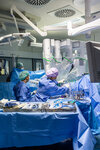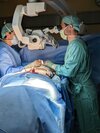Breast reconstruction: Tissue removed from the abdomen using a surgical robot for the first time
Robot-assisted tissue removal for microsurgical breast reconstruction was performed for the first time in Germany at the Medical Center - University of Freiburg / The minimally invasive procedure can avoid complications / High medical requirements
At the Medical Center - University of Freiburg, a 38-year-old patient recently underwent successful microsurgical autologous breast reconstruction with autologous tissue using a robotic assistance system. It was the first procedure of its kind in Germany. This robot-assisted form of surgery is particularly beneficial for women who previously ran a high risk of long-term damage to the abdominal wall as a result of the removal of autologous tissue from the abdominal cavity. The technically and medically very complex operation was carried out in close cooperation between the Department of Plastic Surgery (Acting Medical Director: Prof. Dr. Steffen Eisenhardt), the Department of Urology (Medical Director: Prof. Dr. Christian Gratzke) and the Department of Obstetrics and Gynecology (Medical Director: Prof. Dr. Ingolf Juhasz-Böss).
"This allows us to make breast reconstruction after breast cancer surgery even safer and reduce the side effects of the procedure," says Prof. Dr. Steffen Eisenhardt, Acting Medical Director of the Department of Plastic Surgery at the Medical Center - University of Freiburg.
Breast reconstruction when preservation is not possible
Some breast cancer patients still have to have a breast completely removed. In order to restore their body image, patients can undergo breast reconstruction with their own tissue, known as autologous reconstruction. "Autologous reconstruction already provides long-lasting and excellent results," says Eisenhardt.
The minimally invasive robotic-assisted surgery procedure, which has not yet been established in Germany for this procedure, now makes it possible to perform parts of the operation from inside the abdominal cavity, thereby maintaining the stability of the outer abdominal wall. "Using imaging techniques, we can see in advance exactly which patients are suitable for a robot-assisted procedure and will benefit from it," explains Eisenhardt.
"The surgical method is technically very demanding and requires a lot of experience, which we already have thanks to similar robot-assisted procedures," says Dr. Nikolaos Liakos, senior physician at the Department of Urology at the Medical Center - University of Freiburg. Another decisive factor is the close cooperation and extensive experience of the specialist departments, which is only available in large centers such as the Medical Center - University of Freiburg. "We live close interdisciplinary cooperation for the benefit of our patients. In addition to the experience of our staff, technical progress is crucial here. Together, these two factors make it possible for our patients to gain an absolute advantage," says Eisenhardt.
Image 1: Surgeons can use the surgical robot to remove skin and fatty tissue from the abdomen with millimetre precision and without trembling in order to use it for breast reconstruction.
Image source: Medical Center - University of Freiburg / Britt Schilling
Image 2: Plastic surgeons perform the microsurgical blood vessel suture under the operating microscope to ensure blood flow to the new breast.
Image source: Medical Center - University of Freiburg
Back
Medical Center - University of Freiburg
Central Information
Phone: 0761 270-0
info@uniklinik-freiburg.de
For press inquiries:
Corporate Communications
Breisacher Straße 153
79110 Freiburg
Phone: 0761 270-84830
kommunikation@uniklinik-freiburg.de


